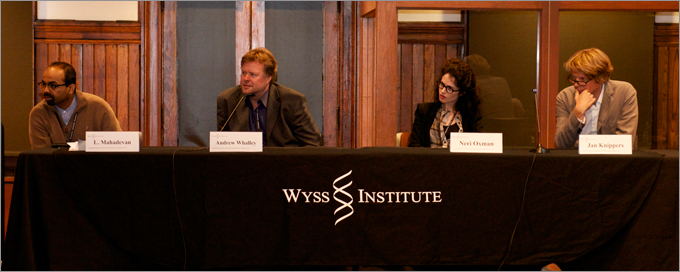The Wyss Institute brings together scientists and industry experts to set a future course for architecture
Nature’s approach to energy efficiency, sustainability, durability, and even aesthetics is often unparalleled. That’s why the materials, structures, and systems demonstrated by living systems offer such promise for the built environment and why the boundaries between science and architecture are increasingly porous.
The Wyss Institute’s first workshop in adaptive architecture — Buildings Inspired by Nature: Inventing the Future Built Environment — served as a critical first step toward removing those boundaries entirely.
Rather than simply reviewing existing work, the Wyss forum brought together diverse members of both the scientific and building industry communities to explore ways in which current research initiatives can best meet today’s real-world social and environmental needs — and to set a future course for architecture.

“We want to create a bridge between two worlds that traditionally don’t talk to each other,” said Wyss Institute core faculty member and event co-leader Joanna Aizenberg, who also heads the Institute’s adaptive architecture initiative. “The best outcome from this meeting would be for us to develop a common language and then see what we can do together.”
In addition to Aizenberg, the two-day workshop was co-led by award-winning architect and Wyss Institute visiting scholar Chuck Hoberman, and Wyss Institute Founding Director Don Ingber. Ingber kicked off the proceedings by introducing the Institute’s unique model and the many ways in which Institute researchers are poised to advance technologies for the future built environment. Attendees then participated in a series of panel discussions and presentations focused on next-generation building materials, designs, intelligence, and energy usage — and on the many challenges in bringing these products and technologies to market.
Aizenberg and other researchers shared the ways in which nature is inspiring the development of new building materials that are self-healing, self-cleaning, and self-assembling; can repel liquids and ice; and can even change light and manage heat transfer. Such materials could be used to create buildings that are energy efficient and provide high air and environmental quality to inhabitants, as well as being aesthetically pleasing and designed to last.
Design structures, intelligent systems, and energy efficiency attributes inspired by nature were also considered. Examples included buildings whose window patterns and sizes are determined on the basis of capturing light, buildings that collect humidity at night and use solar energy during the day to produce water, and buildings in which a structure similar to a tree trunk and branches is embedded in an external wall.
Presenters included Andrew Whalley, Deputy Chairman of Grimshaw, an international design firm; Matthias Schuler, CEO and founder of TRANSSOLAR, a climate engineering consulting company; and Neri Oxman, an architect and designer, who is also an assistant professor of media arts and sciences at the MIT Media Lab.
To ensure that these innovative ideas, discoveries, and approaches were considered through the lens of market realities, the workshop included the voice of industry. For instance, Pat Sapinsley, an investment professional at Good Energies, a global venture capital firm, urged researchers to realize the high premium placed on simplicity. Simon Giles, a Principal at the management consulting firm, Accenture, and an advisor to the World Economic Forum emphasized the need to pursue technologies that can be scaled up rapidly. And Andrew Dent, Vice President at the global materials consultancy, Material ConneXion, Inc., encouraged attendees to consider their own materials in the broader context of industry trends.
The workshop ended with a brainstorming session on future opportunities for collaboration. “One of our goals at the Wyss Institute is to bring together diverse disciplines and areas of expertise in order to reach new levels of innovation,” said Ingber. “It was incredibly inspiring to see the new directions and connections that resulted from applying this model to envision a future in which architecture addresses our most pressing environmental and sustainability issues.”